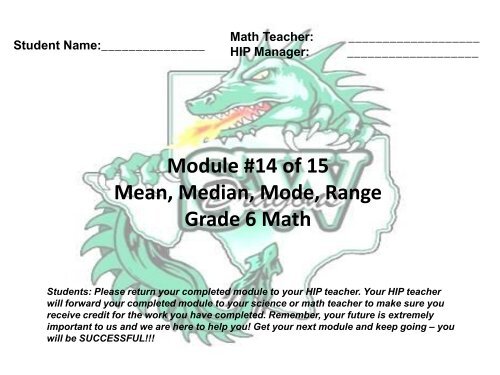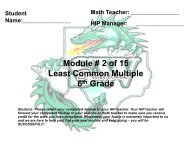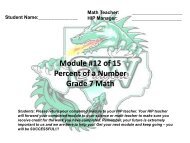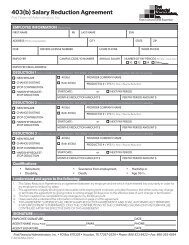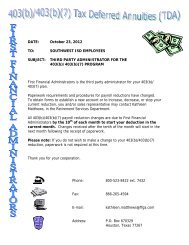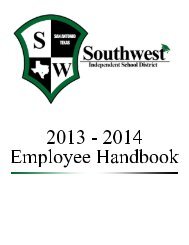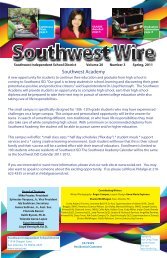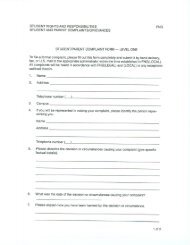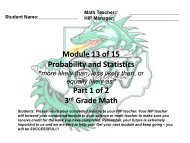Module #14 of 15 Mean, Median, Mode, Range Grade 6 Math
Module #14 of 15 Mean, Median, Mode, Range Grade 6 Math
Module #14 of 15 Mean, Median, Mode, Range Grade 6 Math
You also want an ePaper? Increase the reach of your titles
YUMPU automatically turns print PDFs into web optimized ePapers that Google loves.
Student Name:_______________<br />
<strong>Math</strong> Teacher:<br />
HIP Manager:<br />
___________________<br />
___________________<br />
<strong>Module</strong> <strong>#14</strong> <strong>of</strong> <strong>15</strong><br />
<strong>Mean</strong>, <strong>Median</strong>, <strong>Mode</strong>, <strong>Range</strong><br />
<strong>Grade</strong> 6 <strong>Math</strong><br />
Students: Please return your completed module to your HIP teacher. Your HIP teacher<br />
will forward your completed module to your science or math teacher to make sure you<br />
receive credit for the work you have completed. Remember, your future is extremely<br />
important to us and we are here to help you! Get your next module and keep going – you<br />
will be SUCCESSFUL!!!
<strong>Math</strong> Dragon Presents<br />
“<strong>Mean</strong>, <strong>Median</strong>, <strong>Mode</strong>, <strong>Range</strong>”
<strong>Mean</strong>, <strong>Median</strong>, <strong>Mode</strong>,<br />
<strong>Range</strong><br />
<strong>Mean</strong><br />
= Average<br />
<strong>Median</strong> = Middle<br />
<strong>Mode</strong><br />
= Most<br />
<strong>Range</strong> = Biggest – Smallest<br />
Hints: <strong>Median</strong> and<br />
Middle both have a d<br />
in the middle. <strong>Mode</strong><br />
and Most both have<br />
four letters.
<strong>Mean</strong><br />
<strong>Mean</strong> is the average. To find the mean: add all the numbers in the data set and<br />
divide by how many numbers there are.<br />
<strong>15</strong>, 7, 9, 10, 9, 13, 7<br />
<strong>15</strong><br />
7<br />
9<br />
10<br />
7<br />
9<br />
13<br />
7<br />
The mean is 10.<br />
70<br />
7<br />
10<br />
To find the mean you<br />
don’t have to put the<br />
numbers in order but if<br />
you are going to continue<br />
to use the data set you<br />
should do that first.
<strong>Median</strong><br />
The median is the middle number in a set <strong>of</strong> data. The data MUST be in order<br />
before you find the median.<br />
Example 1:<br />
Find the median.<br />
<strong>15</strong>, 7, 9, 10, 9, 13, 7<br />
First, put the numbers in order: 7, 7, 9, 9, 10, 13, <strong>15</strong><br />
Now find the number in the middle<br />
The median is 9.<br />
If you order the numbers<br />
from least to greatest or<br />
greatest to least, the<br />
same numbers will be in<br />
the middle.
<strong>Median</strong><br />
The median is the middle number in a set <strong>of</strong> data. The data MUST be in order<br />
before you find the median.<br />
Example 2:<br />
Find the median.<br />
21, 18, 16, 8, 23, 20<br />
First, put the numbers in order: 8, 16, 18, 20, 21, 23<br />
Now find the number in the middle.<br />
In this problem, there are two<br />
numbers in the middle…to find the<br />
median, you need to add them<br />
together and divide by 2.<br />
18<br />
20<br />
2<br />
38<br />
2<br />
19<br />
The median is 19.<br />
If you order the numbers<br />
from least to greatest or<br />
greatest to least, the<br />
same numbers will be in<br />
the middle.
<strong>Mode</strong><br />
<strong>Mode</strong> is the number that happens the most in a set <strong>of</strong> data.<br />
Example 1:<br />
Find the mode in the following set <strong>of</strong> numbers:<br />
13, 6, 24, 32, 24, 13, 24, 22, 24, 27<br />
Look for the number that happened the most. The mode is 24.<br />
Example 2:<br />
Find the mode in the following set <strong>of</strong> numbers:<br />
5, 3, 7, 1, 5, 11, 5, 8, 3, 12, 3<br />
This data set has two modes: 3 and 5<br />
because they both happened the most.<br />
It is possible to have no<br />
mode, one mode, or<br />
more than one mode.<br />
Example 3:<br />
Find the mode in the following set <strong>of</strong> numbers:<br />
7, 12, 8, 13, 6, 5, 9, 3<br />
This data set has no mode.
<strong>Range</strong><br />
The range is the biggest number in a data set minus the smallest number.<br />
Find the range <strong>of</strong> the following set <strong>of</strong> numbers:<br />
13, 28, 17, 19, 21, 8, 16, 23<br />
Put the numbers in order<br />
to find the biggest and<br />
the smallest.<br />
8, 13, 16, 17, 19, 21, 23, 28<br />
Subtract the biggest minus the smallest: 28 -8 = 20<br />
<strong>Range</strong> is always the<br />
biggest number in a<br />
data set minus the<br />
smallest.<br />
So the range is 20.
Time to Practice!!!
<strong>Mean</strong>, <strong>Median</strong>, <strong>Mode</strong>,<br />
<strong>Range</strong><br />
<strong>Mean</strong>, <strong>Median</strong>, <strong>Mode</strong> and <strong>Range</strong> are called Measure <strong>of</strong> Central Tendency<br />
because they all measure “centers” <strong>of</strong> the data in different ways.<br />
Find the mean, median, mode and range.<br />
7, 21, <strong>15</strong>, 16, 20, <strong>15</strong>, 8, 10<br />
When you start with a list <strong>of</strong> data, the first thing you should always do is<br />
put the numbers in order<br />
7, 8, 10, <strong>15</strong>, <strong>15</strong>, 16, 18, 21<br />
<strong>Mean</strong> = Average<br />
<strong>Median</strong> = Middle<br />
<strong>Mode</strong> = Most<br />
<strong>Range</strong> = Biggest - Smallest<br />
<strong>Mean</strong>:<br />
<strong>Median</strong>:<br />
7<br />
<strong>15</strong><br />
8<br />
<strong>15</strong><br />
2<br />
10<br />
2<br />
<strong>15</strong><br />
<strong>15</strong><br />
8<br />
16<br />
18<br />
21<br />
8<br />
<strong>Mode</strong>: <strong>Range</strong>: 21 – 7 =<br />
13.75, <strong>15</strong>, <strong>15</strong>, 14
<strong>Mean</strong>, <strong>Median</strong>, <strong>Mode</strong>,<br />
<strong>Range</strong><br />
Find the mean, median, mode and range.<br />
50, 46, 51, 51, 50, 50, 52<br />
When you start with a list <strong>of</strong> data, the first thing you should always do is<br />
put the numbers in order<br />
<strong>Mean</strong>:<br />
<strong>Median</strong>:<br />
46<br />
50<br />
46, 50, 50, 50, 51, 51, 52<br />
50<br />
50<br />
7<br />
51<br />
51<br />
52<br />
7<br />
<strong>Mean</strong> = Average<br />
<strong>Median</strong> = Middle<br />
<strong>Mode</strong> = Most<br />
<strong>Range</strong> = Biggest - Smallest<br />
<strong>Mode</strong>:<br />
<strong>Range</strong>: 52 - 46 =<br />
50, 50, 50, 6
Lets see how much<br />
you have learned!!!
<strong>Mean</strong>, <strong>Median</strong>, <strong>Mode</strong>,<br />
<strong>Range</strong><br />
Find the mean, median, mode and range for the set <strong>of</strong> data.<br />
31, 35, 29, 30, 34<br />
<strong>Mean</strong>:<br />
The first thing you<br />
need to do is put the<br />
numbers in order.<br />
<strong>Median</strong>:<br />
<strong>Mode</strong>:<br />
<strong>Range</strong>:<br />
<strong>Mean</strong> = Average<br />
<strong>Median</strong> = Middle<br />
<strong>Mode</strong> = Most<br />
<strong>Range</strong> = Biggest - Smallest
<strong>Mean</strong>, <strong>Median</strong>, <strong>Mode</strong>,<br />
<strong>Range</strong><br />
Find the mean, median, mode and range for the set <strong>of</strong> data.<br />
5, 3, 2, 7, 5, 3, 4, 3<br />
<strong>Mean</strong>:<br />
The first thing you<br />
need to do is put the<br />
numbers in order.<br />
<strong>Median</strong>:<br />
<strong>Mode</strong>:<br />
<strong>Range</strong>:<br />
<strong>Mean</strong> = Average<br />
<strong>Median</strong> = Middle<br />
<strong>Mode</strong> = Most<br />
<strong>Range</strong> = Biggest - Smallest
How will TAKS ask this problem?<br />
The graph to the right shows the number<br />
<strong>of</strong> years that 5 families have lived in a<br />
neighborhood.<br />
What is the mean number <strong>of</strong><br />
years these families have lived<br />
in this neighborhood?<br />
A 10 years<br />
B 6 years<br />
C 12 years<br />
D 5 years<br />
To find the mean, add all the<br />
numbers together and divide by<br />
how many there are…beware <strong>of</strong><br />
the extra trick in this problem<br />
…each house represents 2 years.
Another TAKS type problem?<br />
The Q & R Band performed concerts from 1992 to 2001. The table shows the<br />
number <strong>of</strong> concerts the band performed each year.<br />
Remember to put the numbers in<br />
order first. If there are two<br />
numbers in the middle then add<br />
them together and divide by two.<br />
What is the median <strong>of</strong> the<br />
number <strong>of</strong> concerts?<br />
A 162<br />
B 170<br />
C 180<br />
D 172
Now you will create a<br />
Problem <strong>of</strong> your own!!!
Create Your Own<br />
• You are going to write your own question about<br />
mean, median, mode and range.<br />
• To find the answer you must have to use the<br />
information we’ve learned in this section.<br />
• Extra points can be earned by drawing a picture<br />
to go with your problem.<br />
• Finally, you need to explain what the correct<br />
answer is and WHY?<br />
• Remember what you learned and don’t be afraid<br />
to take a math adventure like our <strong>Math</strong> Dragon!!
Your Problem
CONGRATULATIONS!!!<br />
JOB WELL DONE, and we will see you again soon in<br />
“<strong>Math</strong> Dragon’s<br />
<strong>Math</strong> Adventure!!”


